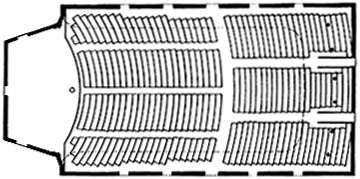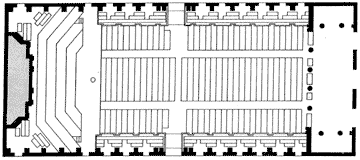RECOMMENDATIONS FOR ACOUSTIC RENOVATIONS
ODESSA PHILHARMONIC ORCHESTRA
Odessa, Ukraine
Artec Report No 7239
Artec Project No 3363
Date: 18 December 1996
Distribution:
Odessa Philharmonic Orchestra -Odessa, Ukraine
Maestro Hobart Earle
American Friends of the Odessa Philharmonic Orchestra
Elizabeth Flemer, President
Swiss Friends of the Odessa Philharmonic Orchestra
Paul M. Van Marx (Switzerland)
ECONOMIC FEASIBILITY STUDIES ![]() THEATRE CONSULTING
THEATRE CONSULTING ![]() ACOUSTICS
ACOUSTICS
114 WEST 26 STREET NEW YORK NY 10001-6812 (212)242-0120 FAX (212) 645-8635






Comments of Musicians that Perform in Hall
Artec had the benefit of meeting with several of the musicians from the Philharmonic Orchestra. Their comments are summarized as follows:
Second Violin:
“I feel that the walls do not reflect enough sound. I don’t hear myself playing.”
String Bass:
“I felt that there was much better balance on stage with the curtains removed.”
Concert Master:
“It is very hard to hear the other musicians on the stage, compared to other halls where the Philharmonic Orchestra has performed.”
Bassoon:
“With the curtains removed I can hear my instrument much better and it is easier to play.”
French horn:
“With the curtains removed we hear an answer from the auditorium that we didn’t -hear before.” (This musician considered this to be an improvement.)
Percussion:
“I can hear the other players in my section better with the curtains removed.”
Maestro Earle:
“The percussion section plays very loudly with the curtains removed. They are used to having to play very hard and will take some time to get used to the change.”
As is obvious from the above comments, most of the musicians were focused on the removal of the curtains from around the stage area. Most musicians agreed that there was a significant change from removing the curtains and that this change was for the better. While we would have liked to learn more about the musician’s opinions of other aspects of the hall’s acoustics, the orchestra was just getting accustomed to the hall without curtains and couldn’t yet comment on the hall more specifically. Maestro Earle should continue to ask the impressions of the musicians as they become more accustomed to hearing each other and the room better.